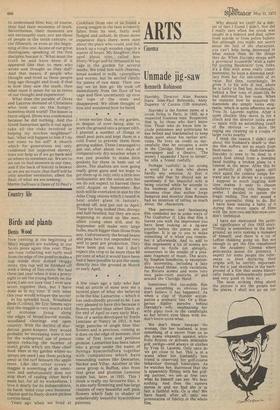Cinema
Unmade jig-saw
Kenneth Robinson
Stavisky. Director: Alan Resnais Stars: Jean-Paul Belmondo, Anny Duperey 'A' Curzon (120 minutes).
Stavisky is the former name of a crook living in Paris, in 1933, as a respected business man. Respected, that is, by those who don't know him. Those who do know him include policemen and politicians he has bribed and blackmailed to keep them quiet about his earlier activities. He lives on credit so successfully that he occupies a suite in the Claridge Hotel and runs a newspaper and a theatre. 'The money I squander I have to invent', he tells a friend ruefully.
Perhaps 'ruefully' is too strong a word for a man who shows hardly any emotion. At first it seems odd that he should ask so carelessly if his beautiful wife is being courted while he attends to his business affairs. But it soon becomes clear that author Jorge Semprun and director Alan Resnais had no intention of telling us much about the characters.
This perverse and fascinating film reminded me in some ways of The Godfather II. Like that film it leaves you with the impression you have been looking at a jig-saw puzzle before the pieces are put together. It is up to you to make something of it when you remember it afterwards. And to add to this impression a lot of scenes are allowed to fizzle out abruptly, sometimes in the middle of a pleasant fragment of music. The score, by Stephen Sondheim, is exceptionally interesting, including a lazy dance-band theme, with variations, for Riviera scenes and some very nice palm-court pastiche in and around the Claridge Hotel.
Sometimes this too-subtle film does something so obvious you don't believe it has happened. As when a clap of thunder accompanies a dramatic line. Or a Hungarian fiddler parades behind Stavisky's wife, emphasising her wild gipsy look in the candlelight as her brown eyes blaze with wedon't-know-quite-what.
We don't know because the woman, like her husband, is kept something of a secret from us as she poses elegantly against white Rolls Royces or delivers delectable golf swings—and always in clothes by Yves St. Laurent. Only once do we get close to her. This is in a scene when her husband's best friend is observing her golf-course behaviour through binoculars. As he watches her, distressed that she is apparently flirting with her golfing partner, we see at first only what he himself can see. We hear nothing. And then the camera moves in and we find she is in fact a faithful wife. Or is she? We have heard, after all, only one protestation of fidelity in the whole film,. Why should we care? As a matter of fact I found I didn't. Nor did I really care when the crook was caught in a hideout and died, either from suicide or from police bullets. But although you might not worry about the fate of the characters, you can't help being interested in what makes them do the things they do. When Stavisky sleeps with a provincial housewife `with a taste for quoting Baudelaire' (yes, folks, it's a film with some really classy moments), he buys a diamond necklace from her for one-tenth of its value. But then, surprisingly, he gives it to his wife in bed, where he is lucky to find her, incidentally, behind a few tons of plant-life he had delivered to her room. When he explains how he acquired the diamonds she simply looks enigmatic, which is quite effective in an Yves St. Laurent nightie. After a quiet chuckle they move in for a clinch and the director looks away — again with an astonishing touch of the obvious — to show the raging sea cleaning up a couple of large rocks nearby. I think the reason I didn't care about the husband's death is that the film suffers not so much from
flash-backs as flash-forwards. Stavisky is seen to be dead in a quick look ahead from a bleeding hand holding a broken glass to a funeral in the snow. After this he is perfectly all right again until once again the camera jumps forward and he is shown as a corpse. I. suppose so much juggling with time makes it easy to choose whichever ending you happen to prefer. I decided to ignore the tragic ending. This may sound a pretty surrealist thing to do. But I have been making a habit of it during the recent spate of films with the now-you-see-him-now-youdon't technique.
I have not mentioned the political significance of this 1933 story. Trotsky is somewhere in the background, an exile making a nuisance of himself, and there is a lot of Leftist thinking going on. But not enough to get the film transferred to the Academy Cinema where polo-necks queue for polemics. I expect for some people the references to Jews declaring their origins will be terribly important. For me it just sketches in the background of a film that seems historically feeble, philosophically puerile and very good to look at. The most striking thing about the picture is not the people but the places. I shall not go on too
much about dappled sunlight tailing on mellow walls. But I must say that some particularly clever things are done with the settings. People we have seen earlier in the film are glimpsed meeting each other again, but as they begin to talk — cycling down a country lane — the car we are seeing them from pulls away. And there, like a slice of life, is an irritating nonevent. Several times too I found myself trying to remember a gate or a lane that had appeared earlier, wondering where they might lead to.
This is not a sensational film. But it is a film of sensations. And if that doesn't seem to mean anything, what about seeing how it affects your own thinking. Good luck.



























 Previous page
Previous page